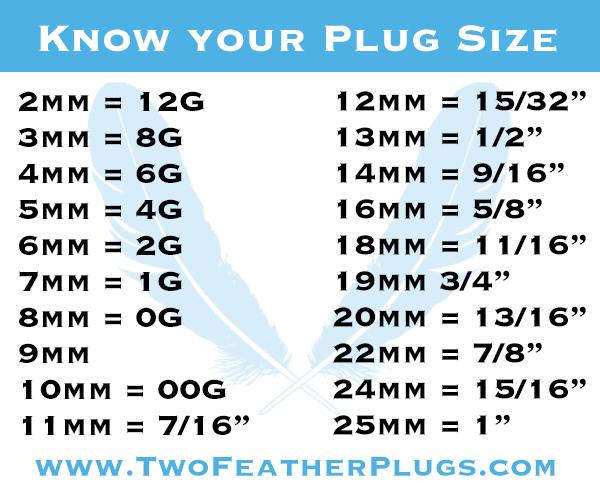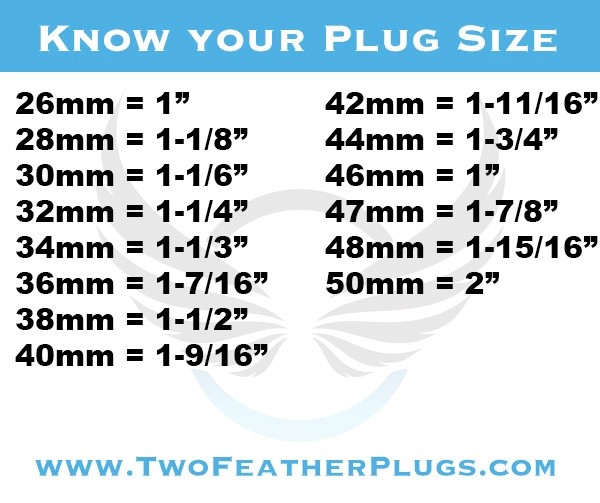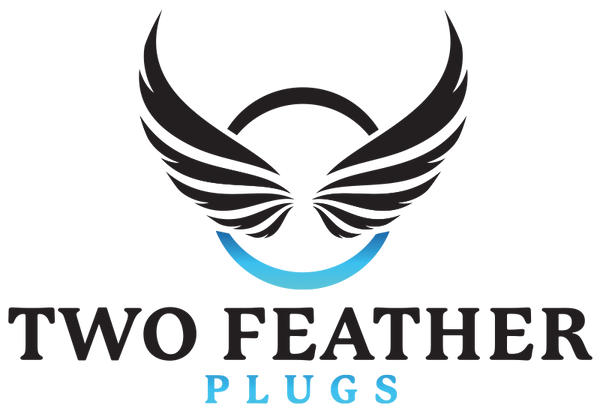Ear Gauge Size Chart
December 24, 2024 / by Alex Peace
What is a 00 gauge plug? Why do some people call them 1/2 inch and others call them 13mm? Welcome to the world of ear gauge sizing. We know that sizing the gauge of your ears might be confusing. If you are new to the world of ear stretching we want you to understand all the terms when it comes to gauges and ear sizing. We will provide you with the proper ear stretching size chart to help you find the proper body jewelry.

Common Ear Gauge Sizes
We have listed some of the most common Ear Gauge sizes for stretched ears. Typical sizing for your ears is measured in either ear gauge, millimeters, and/or inches. Most people refer to smaller size ears in gauge. Once they reach above 00 gauge people size their ears in either millimeters or inches.
We recommend knowing your ear gauge size in millimeters. As we describe below most plugs are carved in millimeters. It will help to know your ear gauge size in millimeters for this reason alone. We did want to show you the conversion of the millimeters into gauges and inch as shown in the "ear gauge size chart". This chart will also help you when it comes to the measurements of other body piercings and body jewelry. It will help you convert from gauge to mm.
Two of the most common sizes people refer to when talking about ears are 0 gauge and 00 gauge. These two gauge sizes seem to be the most common stopping point for the majority of our customers.
Keep in mind there are 7mm and 9mm plug sizes. This is a common size that people skip when they are stretching between 2g to 0g and also 0g to 00g. You can help stretch your ears properly if you do not skip sizes.
What is an Ear Gauge?
The term gauge is actually a measurement. Some people refer to ear plugs as gauges, but in reality, it is a term referring to the size of your plug. It is important to know the gauge system. Gauge sizes for your ear start at a higher number and go to a low number. This system of going from the higher number to the lower number was started because of the British and can be found in a few other industries. Measuring your ear gauge size is one of those industries. Most standard piercings begin at 20 gauge or 18 gauge. If you are starting to stretch your ear this is typically the beginning point. Your first stretch for your ear will typically be at 14 gauge and then 12 gauge. You work your way up to 00 gauge.
When you look at the "Ear Gauging Size Chart" you will see that after 00 gauge you start to move into inches. So after 00 gauge, the next increment would be 7/16 inch plugs. Now the term "gauge sizes" will be no more and you will refer to your stretch size increments in either millimeters or inches.
The fact that ear stretching is done all around the world some of the terms used for ear gauge sizing can be confusing. There are basically three units of measurement that people use while stretching their ears. Most people use either GAUGE, MILLIMETERS, or INCHES.
Most people in the USA use Gauges in the smaller sizes and then inches in the larger sizes. It is easier to convert from gauge to mm. Confusion will start to set in because most all plugs are actually made in millimeters. In order to speak in the American language, the plugs need to be converted to inches. This has always been a hot topic (especially when it comes to 1/2").
Know your ear plug size in millimeters mm
We recommend knowing your plug size in millimeters. Why is it important to learn your plug size in millimeters? We know everyone in the USA love to speak in Inches, but the reality is the majority of plugs are carved in millimeters. The companies that sell plugs online convert millimeters into inches.
Why is there a difference in the size of my 1/2 inch plugs?
If you refer to everything in gauges and inches you typically will be ok up until 00 gauge. Once you hit inches issues start to happen. We find the most common issue is how customers and other plug companies define their half-inch plug. We have found companies selling 12mm and 13mm plugs as 1/2". Others have made 12.7mm plugs to add to the confusion. There are now 12mm, 12.7mm, and 13mm out on the market being referred to as half-inch plugs. If you order half-inch from a company that defines their half-inch as 12mm and then order from another company that defines their half-inch as 13mm your ears will not like you.
Two Feather Plugs refer to our 13mm plugs as our 1/2", but we tell everyone to just measure and buy everything in millimeters. Otherwise, you are going to run into sizing issues. Here is the breakdown on the conversions of the 1/2".
-
12.0mm = 0.472 inches
-
12.7mm = 0.5 inches = 1/2"
-
13mm = 0.51 inches = 33/64" (FYI: 1/2" = 32/64")
Americans like to do everything in inches. I totally get it, but if you order everything in millimeters you are not going to run into issues. Measure your current plugs in millimeters and purchase the plugs based on this size.
How do I know the gauge size of my plugs?
The easiest way to know what gauge size your ears are is to measure your current plugs that fit in your ears. If you have a double flare plug that means measuring the gauge size inside the plug. If you have a single flare plug it is a little easier to measure since most the wearable area of the single flare plugs is the same gauge size. One of the most common ways to measure your current stretched ears is to buy yourself a digital caliper. They are a pretty cheap tool that will give you an exact measurement. The other easy thing to do is to pop into your local piercers shop and have him or her measure your stretched ears for you. Honestly though they will probably just use the same caliper that you can purchase.
Which ear gauge size should I purchase online?
When looking online you will see a variety of different types of plugs to choose from. Each one will have a different ear gauge size available. The most common plugs we sell are our double flare plugs. When you purchase the plug you will be purchasing the size for the inner measurement of the plug. So if you have 00 gauge ears you would purchase the 00 gauge double flare plugs. This means the inner diameter of the plug will be 00 gauge and there will be a outer flare that will be a little larger than this (typically 2mm).
What about Saddles and Coffins? What ear gauge size is correct?
We often here our customers say that they prefer to purchase a coffin that is a smaller gauge size than their normal round plug gauge size. While this is perfectly ok that is not how we measure our ear gauge size for shaped plugs like coffins or teardrops. We measure these gauge sizes so if you normally wear a 00 gauge round plug you would also purchase a 00 gauge coffin or teardrop. Your stretched ears are typically not used to the shape size change. So they might take a little bit longer to get into your stretched ears.
What Ear Gauge Sizes do you have available?
We sell a wide variety of gauge sizes for your stretched ears. Whether you are just starting off or have been having stretched ear for years we have your gauge sizes in mind. If you just started stretched your ears you will start off at a lower gauge size like 12 gauge or 8 gauge. We also have the larger sizes all the way up to 40mm. We do tend to stick to the most common gauge sizes as we do not want our artwork to sit on the shelves, but occasionally we add to are larger size. We do understand that some people have larger sizes like 50mm, but we have not had a lot of success selling these larger plugs and tunnels.

Ear gauge size chart up to 2 inches
Our customers have been asking for gauge sizes for plugs up to 2 inches. We wanted to give you the conversions chart form inches to millimeters mm for plugs that are a larger sizes. Below is the larger ear gauge size chart.
We always recommend using a professional piercer, buy our ear stretching kit is a great way to start stretching your ears. Please remember to always move slowly when stretching your ears. For more information please click... Stretch your ears Slowly
Gauge Size for other body piercings
Most all body jewelry has the same gauge measuring system as we have talked about above. Measuring nose piercing, septum piercings, ear piercings and others follows the same gauge sizes as ear gauge sizes. Using a calipers you would measure the external diameter. For more information about measuring nose piercings or septum piercings click here
If you have any questions about ear gauge sizes please email us at twofeatherinfo@gmail.com
Keep up with the latest
in the ear stretching community
Sign up to the Two Feather Plugs Newsletter
For more ear stretching topics please click below...






